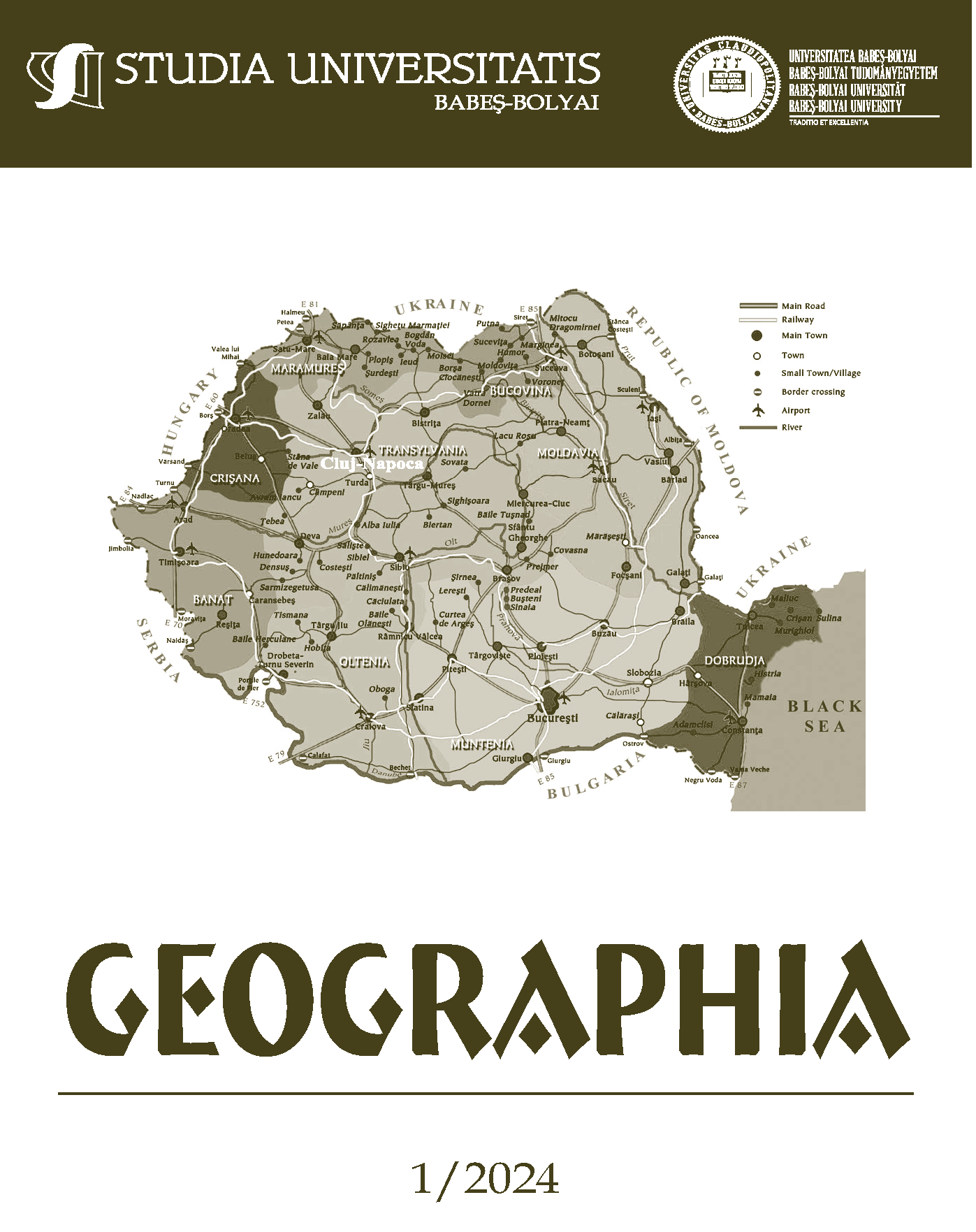Evaluation of the Geotourism Potential of the Mountain Lakes in the Călimani Massif: Colibița Lake, Iezer Lake and Zânelor Lake
DOI:
https://doi.org/10.24193/subbgeogr.2024.1.07Keywords:
Geotourism, Geosite, Călimani Massif, Carpathian Mountains, RomaniaAbstract
Evaluation of the Geotourism Potential of the Mountain Lakes in the Călimani Massif: Colibița Lake, Iezer Lake and Zânelor Lake. This paper evaluates the key geosites in the Călimani National Park: Colibița Lake, Iezer Lake and Zânelor Lake. The internationally recognized methodology used in this study has a crucial role in the development of tourism and the conservation of natural resources. The obtained results show that these geosites have a significant potential for tourism development. Colibița Lake, an artificial lake, attracts tourists with its picturesque landscape and recreational activities. Iezer Lake impresses with its natural beauty and ecological importance, being a crucial habitat for local flora and fauna. Zânelor Lake offers a unique cultural experience, thanks to the charming landscape and local legends. The evaluation and management of these geosites will contribute to the management and conservation of natural resources in the Călimani Massif. The development of sustainable tourism requires appropriate management strategies that ensure responsible use and conservation of the environment. Promoting sustainable tourism and respecting conservation principles will ensure the preservation and sustainable exploitation of these geosites, benefiting both local communities and visitors.
References
Amiri, M., Nohegar, A., & Bouzari, S. (2018), Potential Assessment of Geomorphological Landforms of the Mountainous Highland Region, Haraz Watershed, Mazandaran, Iran, Using the Pralong Method, Pollution, 4 (3). https://doi.org/10.22059/poll.2018.240018.302.
Bâca, I. (2010), Tăul Zânelor from Colibița – Morphotouristic Characterisation, Analele Științifice ale Universității "Al. I. Cuza" Iași. Tom LVI, Seria II, Geografie.
Bâca, I. (2011), Contributions to inventory and assessment of the geomorphosites in Călimani National Park: Case study - 12 Apostles Geologic Reserve, Analele Universității din Oradea - Seria Geografie, X, no. 212102-55447, retrieved from http://istgeorelint.uoradea.ro/Reviste/Anale/anale.htm.
Bâca, I., & Șteff, I. (2014), Poveștile Colibiței (Seria Terra), Argonaut, Cluj-Napoca, 229 p.
Brilha, J. (2016), Inventory and Quantitative Assessment of Geosites and Geodiversity Sites: A Review, Geoheritage, 8 (2), 119–134. https://doi.org/10.1007/s12371-014-0139-3
Bruschi, V. M., & Cendrero, A. (2005), Geosite Evaluation; Can We Measure Intangible Values? Il Quaternario Italian Journal of Quaternary Sciences, 18 (1), Special Volume, 293-306, Department of Earth Sciences and Condensed Matter Physics (CITIMAC), Faculty of Sciences, University of Cantabria.
Catana, M. M., & Brilha, J. B. (2020), The Role of UNESCO Global Geoparks in Promoting Geosciences Education for Sustainability. Geoheritage, 12 (1), 1. https://doi.org/10.1007/s12371-020-00440-z.
Chakraborty, A., Mokudai, K., Cooper, M., Watanabe, M., & Chakraborty, S. (Eds.) (2018), Natural Heritage of Japan, Springer International Publishing. https://doi.org/10.1007/978-3-319-61896-8.
Cocean, G. (2011), The Relationship between Relief and Tourism in the Trascău Mountains, Babeş-Bolyai University, Faculty of Geography, 1–34.
Gordon, J. (2018), Geoheritage, Geotourism and the Cultural Landscape: Enhancing the Visitor Experience and Promoting Geoconservation, Geosciences, 8 (4), 136. https://doi.org/10.3390/geosciences8040136.
Martins, B., & Pereira, A. (2018), Residents’ Perception and Assessment of Geomorphosites of the Alvão—Chaves Region, Geosciences, 8 (10), 381. https://doi.org/10.3390/geosciences8100381.
Panizza, M. (2001), Geomorphosites: Concepts, methods and examples of geomorphological survey, Chinese Science Bulletin, 46 (S1), 4–5. https://doi.org/10.1007/BF03187227.
Pereira, D. I., Pereira, P., Brilha, J., & Cunha, P. P. (2015), The Iberian Massif Landscape and Fluvial Network in Portugal: A geoheritage inventory based on the scientific value, Proceedings of the Geologists’ Association, 126 (2), 252–265. https://doi.org/10.1016/j.pgeola.2015.01.003.
Pereira, P., & Pereira, D. (2010), Methodological guidelines for geomorphosite assessment, Géomorphologie: Relief, Processus, Environnement, 16 (2), 215–222. https://doi.org/10.4000/geomorphologie.7942.
Phuong, T. H., Duong, N.-T., Hai, T. Q., & Van Dong, B. (2017), Evaluation of the geological heritage of the Dray Nur and Dray Sap waterfalls in the Central Highlands of Vietnam, Geoheritage, 9 (1), 49–57. https://doi.org/10.1007/s12371-016-0176-1.
Planul de management integrat pentru situl Natura 2000 ROSCI0051 Cuşma (2015).
Pralong, J.-P. (2005), A method for assessing tourist potential and use of geomorphological sites, Géomorphologie: Relief Processus Environnement, 11, 189–196.
Reynard, E., Coratza, P., & Géral, A. (2009), Geomorphosites, Verlag Dr. Friedrich Pfeil, München.
Romsilva (2022), The Management Plan of the Călimani National Park, the Site of Community Importance ROSCI0019 Călimani-Gurghiu (the part that overlaps with the Călimani National Park), the Special Protection Area ROSPA0133 Călimani Mountains for Birdlife, and the areas protected for national interest overlapping with it.
Rus, O. (2018), The Geomorphosites of the Harghita Mountains, Babeș-Bolyai University, Cluj-Napoca, Faculty of Geography.
Stoica, D.-L. (2007), Research on Physical Geography on the Northern Slope of the Călimani Massif, Terra Nostra, Iași.
Toma, C. B. (2012), Geomorphosites on Salt in the Transylvanian Depression and Their Touristic Valorization, Doctoral dissertation, Babeș-Bolyai University, Faculty of Geography, Cluj-Napoca.
Warowna, J., Zgłobicki, W., Gajek, G., Telecka, M., Kołodyńska-Gawrysiak, R., & Zieliński, P. (2014), Geomorphosite Assessment in the Proposed Geopark Vistula River Gap (E Poland), Quaestiones Geographicae, 33 (3), 173–180. https://doi.org/10.2478/quageo-2014-0040.
Downloads
Published
How to Cite
Issue
Section
License
Copyright (c) 2024 Studia Universitatis Babeș-Bolyai Geographia

This work is licensed under a Creative Commons Attribution-NonCommercial-NoDerivatives 4.0 International License.


 ©Studia Universitatis Babeş-Bolyai Geographia. Published by Babeș-Bolyai University.
©Studia Universitatis Babeş-Bolyai Geographia. Published by Babeș-Bolyai University.